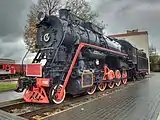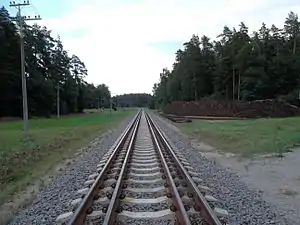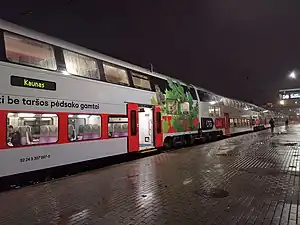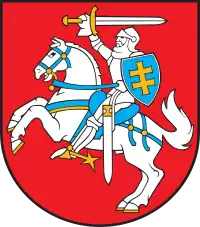| Rail transport in Lithuania | |||||
|---|---|---|---|---|---|
 Train near Vilnius | |||||
| Operation | |||||
| National railway | Lietuvos Geležinkeliai (LTG) | ||||
| Statistics | |||||
| Ridership | 5.5 million (2019)[1] | ||||
| Passenger km | 359 million (2019)[2] | ||||
| Freight | 16,181 million tkm (2019)[2] | ||||
| System length | |||||
| Total | 1,910 km (1,190 mi) | ||||
| Double track | 459 km (285 mi)[3] | ||||
| Electrified | 156 km (97 mi)[3] | ||||
| Track gauge | |||||
| Main | 1,520 mm (4 ft 11+27⁄32 in) 1,435 mm (4 ft 8+1⁄2 in) | ||||
| 1520 mm | 1,745.8 km (1,084.8 mi) | ||||
| 1435 mm | 123 km (76 mi) | ||||
| 750 mm | 68.4 km (42.5 mi) | ||||
| Electrification | |||||
| Main | 25 kV AC, 50 Hz | ||||
| Features | |||||
| Longest tunnel | Kaunas Railway Tunnel, 1,285 m (4,216 ft) | ||||
| No. bridges | 410[4] | ||||
| Longest bridge | Lyduvėnai Bridge, 599 m (1,965 ft)[5] | ||||
| No. stations | 104[4] (or 164 if including all stops)[3] | ||||
| |||||
Rail transport in Lithuania consists of freight shipments and passenger services. The construction of the first railway line in Lithuania began in 1859. As of 2021, the total length of railways in Lithuania was 1,868.8 km (1,161.2 mi). Lietuvos Geležinkeliai, the national state-owned railway company, operates most of the passenger and freight services.
The country has a mixed gauge network: the majority is broad gauge (a legacy of the Russian standard) with rapidly expanding lines using the standard gauge or dual gauge track. In 2020, Lithuania together with the other Baltic states began construction of the Rail Baltica high-speed rail with operating speed of 249 km/h for the passenger trains. The project marks a new era for Lithuanian railways and is expected to be completed by 2030.
Lithuania is a member of the Intergovernmental Organisation for International Carriage by Rail (OTIF) and International Union of Railways (UIC). The UIC Country Code for Lithuania is 24. As an EU member, the country participates in the European Union Agency for Railways. It is also a member of Interrail and Eurail. Lithuania was ranked 16th among national European rail systems in the European Railway Performance Index 2017 assessing intensity of use, quality of service and safety.[6]
History
In 1851, the government of the Russian Empire decided to build the Saint Petersburg–Warsaw railway.[7] The construction of the railway in Lithuania began in 1859 and the line included Daugavpils–Vilnius–Grodno and Lentvaris–Kaunas–Virbalis sections which were completed in 1862.[7] The first train arrived from Daugavpils (in Latvia) to Vilnius on 17 September 1860.[4] However, the first commercial operation began between Kaunas temporary station on the left bank of the river Nemunas and Eydtkuhnen in East Prussia on 11 April 1861. Initially, there were 21 Lithuanian stations.[7] Building of the railway required different engineering solutions, including the construction of Kaunas Railway Tunnel and Paneriai Tunnel.[8] The greatest expansion of the railway happened during 1857–1914 when nearly two thirds of the network, used at the end of 20th century, was constructed.[4] The railway construction had a significant impact to the economic development of the region.[9]
When the Imperial German Army occupied Lithuania in 1915, the railway became the main way to supply food and ammunition for the German army.[9] During this time, Germans replaced a lot of the 1524 mm gauge railways track with the 1435 mm standard gauge.[8] In various parts of the country, the German army also constructed 600 mm gauge tracks.[8] Lithuanian independence was restored in 1918 and the Lithuanian government concluded an agreement with Germany on 4 July 1919 on the handover of the railway assets to the Ministry of Transport.[8] During the years after World War I, Lithuanian Railways reconstructed the tracks, connecting them into a complete network. In 1923 the Klaipėda region was reunited with Lithuania and the port of Klaipėda became a part of the Lithuanian railway system.[9] The interwar period was marked by the expansion of the narrow gauge railways which contributed to the economic development of the rural areas, especially in the north-eastern Lithuania.[9]
In 1940, following the Soviet occupation, railway activities were reorganized and all agreements concluded by Lithuania with neighbouring countries terminated. Soviets changed most of the network from the standard gauge to broad gauge.[7] The railway gauge was again changed by Nazi occupying force in 1941 and then once again changed back by the Soviets in 1944.[7] After the World War II, the railway network required significant repairs. The Soviets also replaced a lot of the narrow gauge railway with the broad gauge and, in fact, completely dismantled 400 kilometres (250 mi) of it.[9][4] During the Soviet occupation all railways in the Baltic states were managed from Riga.[7] The first electric train began service on 29 December 1975 after the electrification of the Vilnius–Kaunas line.[7]
Following the independence restoration in 1991, Lithuania restored its membership in international rail transport organizations, established national railway company Lietuvos geležinkeliai AB and began gradual modernization of its railway network. In 2000s, that included speed improvements (up to 160 km/h — passenger trains, 120 km/h — freight trains), modern communication and safety systems (GSM-R and ERTMS), new trains and locomotives (manufactured by Siemens AG, Pesa, Škoda).[7] In 2020, the construction of the high-speed Rail Baltica began.
 Construction of Kaunas Railway Tunnel, 19th century
Construction of Kaunas Railway Tunnel, 19th century.jpg.webp) Vilnius railway station in 1920
Vilnius railway station in 1920%252C_1937.jpg.webp) The hat of a watchman of a Lithuanian railway station in 1937
The hat of a watchman of a Lithuanian railway station in 1937 L-1160 steam locomotive in Klaipėda railway station
L-1160 steam locomotive in Klaipėda railway station
Trams
In late 19th and early 20th centuries, some Lithuanian cities used the wagonways i.e. trams pulled by horses which were colloquially called "konkė".[10] Kaunas had one wagonway line from 1892 until 1929.[11] Vilnius had three wagonway lines from 1893 to 1925 using the metre-gauge railway.[10] The wagonways lost popularity due to the emergence of buses and cars. Vilnius, however, briefly had a diesel tramway with a sole line between 1924 and 1926[10] and Kaunas had a narrow gauge passenger line of steam tramway, called kukushka before 1935.[12] During the interwar period there were plans to revive electric tramways both in Vilnius and Kaunas, but they never materialized. Klaipėda, on the other hand, had an electric tramway with 2 active lines from 1904 to 1934.[13] It was revived again in 1950 but due to the lack of popularity closed in 1967.[14]
Services

National state-owned railway company Lietuvos Geležinkeliai (abbreviated LTG) provides most of the rail services through its subsidiary companies: LTG Link provides passenger services, while LTG Cargo provides freight service.[15] Another subsidiary, LTG Infra, is responsible for the maintenance and development of the infrastructure.
| Passenger and freight rail transport statistics[4][1] | ||||||||
|---|---|---|---|---|---|---|---|---|
| Year | 1950 | 1960 | 1970 | 1980 | 1990 | 2000 | 2010 | 2020 |
| Passenger km (in mln) | 815 | 1,268 | 2,093 | 3,199 | 3,640 | 611 | 373 | 260 |
| Freight tkm (in bln) | 2.1 | 6.8 | 13.5 | 18.2 | 19.2 | 8.9 | 13.4 | 15.9 |
Passenger transport
Main lines:
- Vilnius—Kaunas, 104 km (65 mi), first built in 1862, electrified in 1975.[7] The fastest train takes 69 minutes, but following the Rail Baltica project completion, the travel time will be reduced to 38 minutes.[16]
- Vilnius—Klaipėda, 376 km (234 mi), part of the line first built in 1870, electrification currently in progress.[17]
International lines:
Vilnius—Riga—Tallinn and Vilnius—Warsaw passenger train routes are technically possible, but currently not practical due to limited speeds and long travel times.[19] These routes will start following the completion of the Rail Baltica project.[19]
The old fleet of passenger trains included the ER9M electric train; D1, DR1A/DR1AM and AR2 diesel multiple units; TEP60/TEP70/TEP70BS and M62/2M62/2M62U diesel locomotives.[20] Some are still in service, but the vast majority are retired.
As of 2021, the main passenger train models include Škoda EJ575 (electric) and diesel Pesa 620M/630M/730ML as well as some RA2 trains. A public procurement was launched in 2021 to replace all diesel passenger trains with a fleet of new electric trains.[15] In 2023, LTG Link signed a contract with the Swiss Stadler Rail company for a delivery of 15 new Stadler FLIRT electric and battery-electric trains.[21] The contract also provides an option for another 39 trains.[21]
Freight transport

As of 2021, Lithuania has three intermodal terminals:[22]
- Kaunas Intermodal Terminal with annual capacity of 102,000 TEU and dual gauge railway;
- Vilnius Intermodal Terminal, 102,000 TEU, broad gauge railway only;
- Šeštokai Intermodal Terminal, 25,000 TEU, dual gauge.
LTG Cargo company provides freight transportation corridors for or between the following regions:
- Western/Northern Europe and Lithuania, primarily Kaunas Intermodal Terminal.[23] Currently, there are regular Kaunas–Tilburg (Netherlands) and Kaunas–Kaldenkirchen (Germany) freight trains.[24][25]
- All three Baltic states with a corridor from/to Poland. "Amber Train" project currently provides Kaunas–Riga–Tallinn (Muuga) service.[26] LTG Cargo Polska (subsidiary in Poland) offers transportation from Šeštokai near the Polish border.[27]
- The Baltic Sea region (primarily Scandinavia) and the Black Sea region, primarily Turkey and Caucasus, via Ukraine.[28][29] "Viking Train" and "Baltic Ukraine Shuttle" are the international projects which enable Klaipėda–Minsk–Kyiv–Odesa transportation corridor between the Port of Klaipėda and the Port of Odesa.[30][29]
- The EU market, as Lithuania is a member, and China via the CIS countries.[22] Lithuania aims to expand its involvement in the New Silk Road and become one of the transport hubs. However, due to strained political relations, the expansion remains uncertain.[31]
LTG Cargo primarily uses Siemens ER20 "Eurorunner" locomotives for the freight trains.[32]
Network

As of 2021, there is a total of 1,910 km (1,190 mi) of railways:[3]
- Single-track — 1,448 kilometres (900 mi) (of which 150 kilometres (93 mi) electrified)
- Double-track — 459 kilometres (285 mi) (of which 5 kilometres (3.1 mi) electrified)
- Triple-track — 2 kilometres (1.2 mi)
- Total electrified — 156 kilometres (97 mi)
Length by track gauge:[3]
- 1,520 mm (4 ft 11+27⁄32 in) broad gauge — 1,790 kilometres (1,110 mi)
- 1,435 mm (4 ft 8+1⁄2 in) standard gauge — 123 kilometres (76 mi)
- 750 mm (2 ft 5+1⁄2 in) narrow gauge — 68.4 kilometres (42.5 mi)
Line between Mockava and Šeštokai uses dual gauge supporting both the broad and standard gauge.[3]
Electrification
Lithuania uses 25 kV 50 Hz AC for the electrified railway lines.[33] This will remain compatible with the technical requirements for the Rail Baltica high-speed rail. The electrification was first implemented in 1975 for the Vilnius–Kaunas line.[7] This was followed by the electrification of Vilnius–Naujoji Vilnia, Vilnius–Trakai lines and, since 2017, Vilnius–Minsk line.[34]
As of 2021, only 10% of the railways in Lithuania are electrified, but major electrification projects are in progress with the intention of achieving 50%.[35] In 2019, a joint consortium of Spanish companies Elecnor and Abengoa was awarded a contract to carry out electrification of 730 km (450 mi) of railway.[36] In October 2022, a contract was awarded to ABB to supply 25kV AC electrification system.[37] It primarily includes the electrification of the Vilnius–Klaipėda line and a bypass rail around Vilnius. In 2020, LTG set itself a long-term goal of achieving zero CO2 emissions by 2030.[15] In 2021, LTG Link announced the public procurement to acquire 30 electric trains in order to replace the existing diesel fleet.[38] In June 2023, LTG Link ordered 15 FLIRT multiple-units and plans to procure up to 13 additional Flirt inter-city EMUs, 15 battery-electric Flirt trains with a 100km range and 11 battery-electric Flirt multiple-units with a 70km range.[39]
Narrow-gauge
_(http-www.siaurukas.eu-)_-_panoramio.jpg.webp)
Lithuania has a narrow gauge line of 750 mm (2 ft 5+1⁄2 in) first constructed in 1891.[40] It was built as a cheaper alternative to the wider gauge railway.[8] In 1996, the narrow gauge railway was declared a heritage railway and, in 2003, the Panevėžys–Anykščiai–Rubikiai line was included into the national list of preserved cultural heritages.[41] The total length of the preserved railway is 179 km (111 mi).[40] Today, the active part of the railway is 68.4 km (42.5 mi), making it one of the longest narrow gauge lines in Europe.[42]
In 2001, Aukštaitija narrow gauge railway was established as a separate company (independent from the Lithuanian Railways) to manage the narrow gauge railway.[40] It primarily runs services for tourism and entertainment.[40] It operates tourist trains ran by the TU2 diesel locomotives.[43]
Future expansion
Rail Baltica is an ongoing greenfield railway infrastructure project which will link all Baltic States, including Lithuania, Poland and, eventually, Finland. Being a part of the Trans-European Transport Networks (TEN-T), it is one of the priority projects of the European Union.[44] It will introduce standard-gauge high-speed rail with an operating speed of 249 km/h for passenger trains.[44] As of 2023, the Rail Baltica project completion is scheduled for 2030, with a start of services on some of the sections in 2028.[45]
In Lithuania, 392 km (244 mi) of new track will be constructed, including the reconstruction of the Vilnius–Kaunas Railway to support standard gauge.[46] High speed rail will reduce the Vilnius—Kaunas route time to 38 minutes.[16] At project completion, the following routes will become available or faster (with projected travel times):[16]
- Vilnius—Warsaw (4:07)
- Vilnius—Riga (1:54, while currently it is 4:15)[18]
- Vilnius—Tallinn (3:38)
As of 2021, the project is in progress with major construction ongoing in Lithuania. The standard gauge line between the Polish border and Kaunas has been built, with freight services already operating between Germany and Kaunas Intermodal Terminal as well as passenger train service between Kaunas and Białystok.[46] The construction works for the line between Kaunas and the Latvian border are expected to begin in 2021.[46]
 Map of Rail Baltica with the main stations
Map of Rail Baltica with the main stations
 Rail Baltica track in Rokai (Kaunas district)
Rail Baltica track in Rokai (Kaunas district)
Conversion to Standard Gauge
A 2022 European Union proposal is for all new rail lines to be Standard Gauge and a rolling plan introduced to convert other gauges to European standard gauge.[47]
Rail links with adjacent countries
 — Latvia, same gauge (1520 mm)
— Latvia, same gauge (1520 mm) — Poland, dual gauge (1435 mm and 1520 mm)
— Poland, dual gauge (1435 mm and 1520 mm) — Belarus, same gauge (1520 mm)
— Belarus, same gauge (1520 mm) — Kaliningrad Railway with Russia, same gauge (1520 mm)
— Kaliningrad Railway with Russia, same gauge (1520 mm)
Gallery
.jpg.webp)
 LTG Link service Vilnius–Kaunas
LTG Link service Vilnius–Kaunas.jpg.webp) Train in Klaipėda railway station
Train in Klaipėda railway station_(cropped).jpg.webp) Škoda EJ575-007 train
Škoda EJ575-007 train.jpg.webp) Train station at Vilnius Airport
Train station at Vilnius Airport
See also
References
- 1 2 "AB "Lietuvos geležinkeliai" 2020 Metinė ataskaita" (PDF) (in Lithuanian). Lietuvos geležinkeliai. Archived from the original on 16 October 2021. Retrieved 16 October 2021.
- 1 2 "Country Profile – Lithuania". United Nations Economic Commission for Europe. Retrieved 2 October 2021.
- 1 2 3 4 5 6 "Viešosios geležinkelių infrastruktūros 2021–2022 metų tarnybinio traukinių tvarkaraščio tinklo nuostatai" (PDF). LTG Infra (in Lithuanian). 2020. Archived (PDF) from the original on 11 October 2021. Retrieved 11 October 2021.
- 1 2 3 4 5 6 Baublys, Adolfas. "Lietuvos geležinkelių transportas". Visuotinė lietuvių enciklopedija (in Lithuanian). Retrieved 2 October 2021.
- ↑ "LTG Infra seeks contractor to construct longest railway bridge in the Baltic region". Railway Technology. 29 December 2020. Archived from the original on 27 January 2021. Retrieved 10 October 2021.
- ↑ "The 2017 European Railway Performance Index". Boston Consulting Group. 8 January 2021. Archived from the original on 16 October 2021.
- 1 2 3 4 5 6 7 8 9 10 "Geležinkelių infrastruktūros istorija". LTG Infra (in Lithuanian). Archived from the original on 28 January 2021. Retrieved 2 October 2021.
- 1 2 3 4 5 "Lietuvos geležinkelių istorija". Lietuvos Geležinkeliai (in Lithuanian). Archived from the original on 16 January 2021. Retrieved 2 October 2021.
- 1 2 3 4 5 Taparauskaitė, Iveta (2010). "Development of Lithuanian railways". Žiemgala (in Lithuanian) (2): 32–37. ISSN 1392-3781. Retrieved 2 October 2021.
- 1 2 3 "Vilnius irgi turėjo tramvajų". Made in Vilnius (in Lithuanian). 21 November 2020. Archived from the original on 28 November 2020. Retrieved 15 October 2021.
- ↑ "Laikinosios sostinės fenomenas". Kauno Diena (in Lithuanian). 17 February 2007. Archived from the original on 6 February 2017. Retrieved 10 October 2021.
- ↑ Kai Kaune dar puškavo „kukuška“
- ↑ "Elektrinis Klaipėdos stebuklas – vienintelis toks Lietuvoje". lrytas.lt (in Lithuanian). 29 August 2017. Archived from the original on 19 October 2021. Retrieved 15 October 2021.
- ↑ "Klaipėda gaivina tramvajaus tradicijas". Lietuvos Žinios (in Lithuanian). 29 July 2017. Archived from the original on 15 September 2017. Retrieved 10 October 2021.
- 1 2 3 "New structure boosts Lithuanian Railways' competitiveness". IRJ. 5 November 2020. Retrieved 10 October 2021.
- 1 2 3 "Bendra informacija apie projektą". Rail Baltica (in Lithuanian). Archived from the original on 29 January 2021. Retrieved 4 October 2021.
- ↑ "Trumpės kelionė iš Vilniaus į Klaipėdą". TV3.lt (in Lithuanian). 6 January 2019. Archived from the original on 19 October 2021. Retrieved 10 October 2021.
- 1 2 "Vilnius-Riga train – what you need to know". LRT. 20 November 2023. Retrieved 28 December 2023.
- 1 2 "Taliną traukiniu iš Vilniaus būtų galima pasiekti ir iki nutiesiant "Rail Balticą", bet reikia susitarti". LRT (in Lithuanian). 23 September 2021. Retrieved 16 October 2021.
- ↑ "Lokomotyvų M62, TEM2, ČME-3, M62K, ČME3MG,ER20CF, ČME3ME, 2M62M, TEM TMH ir lokomotyvų brigadų naudojimas ūkiniams darbams atlikti". Lietuvos Geležinkeliai (in Lithuanian). Archived from the original on 15 October 2021. Retrieved 15 October 2021.
- 1 2 "Stadler to roll out FLIRT in Lithuania". Railway Technology. 22 June 2023. Retrieved 22 June 2023.
- 1 2 "This is where 2020 has got Lithuania on the international railway map". Rail Freight. 8 January 2021. Retrieved 16 October 2021.
- ↑ "Semi-trailer transportation". LTG Cargo. Archived from the original on 16 October 2021. Retrieved 16 October 2021.
- ↑ "First train from Tilburg inaugurates Kaunas Intermodal Terminal". Rail Freight. 20 July 2021. Retrieved 16 October 2021.
- ↑ "Rolling highway from Germany to Lithuania a new success for modal shift". Rail Freight. 20 May 2020. Retrieved 16 October 2021.
- ↑ "Amber Train". LTG Cargo. Archived from the original on 19 October 2021. Retrieved 16 October 2021.
- ↑ "Skuodis: Lithuania supports Poland's objective to include the Via Carpathia route in the Trans-European Transport Network". Delfi. 1 March 2021. Retrieved 16 October 2021.
- ↑ "New container train between Baltic and Black Sea". Rail Freight. 3 June 2019. Retrieved 16 October 2021.
- 1 2 "Viking Train". LTG Cargo. Archived from the original on 19 October 2021. Retrieved 16 October 2021.
- ↑ "Lithuania-Ukraine seal rail cooperation". Rail Freight. 22 March 2021. Retrieved 16 October 2021.
- ↑ "China halts rail freight to Lithuania as feud deepens over Taiwan". South China Morning Post. 18 August 2021. Retrieved 16 October 2021.
- ↑ "Diesel-electric freight locomotive Eurorunner ER20 CF for Lithuanian Railways (LG)" (PDF). Archived from the original (PDF) on 31 October 2007. Retrieved 23 January 2009.
- ↑ "Analysis of Determinative Parameters for Maintaining the Technical and operational compatibility of 1520 mm and 1435 mm gauge railway systems at the CIS-EU border" (PDF). EU Agency for Railways. 2010. Retrieved 10 October 2021.
- ↑ "Oficialiai atidarytas elektrifikuotas geležinkelio ruožas Minskas – Vilnius". Ministry of Foreign Affairs (in Lithuanian). 18 September 2017. Archived from the original on 19 October 2021. Retrieved 10 October 2021.
- ↑ "Lietuvos geležinkelių ateitis: elektrifikacija ties "Rail Baltica" ir ruožu Vilnius–Klaipėda nesibaigs". LRT (in Lithuanian). 19 January 2021. Retrieved 10 October 2021.
- ↑ "Lithuanian railway network awards Elecnor one of its strategic projects". Elecnor. 20 December 2019. Archived from the original on 25 December 2019. Retrieved 10 October 2021.
- ↑ Artymiuk, Simon (21 October 2022). "Vilnius - Klaipeda electrification contract signed". International Railway Journal.
- ↑ "LTG Link to acquire 30 new electric trains". IRJ. 5 January 2021. Retrieved 10 October 2021.
- ↑ Briginshaw, David (21 June 2023). "Stadler wins its first train order in Lithuania". International Railway Journal. Retrieved 23 June 2023.
- 1 2 3 4 "Siaurukas :: Istorija". Siaurukas (in Lithuanian). 9 July 2021. Archived from the original on 20 July 2021. Retrieved 10 October 2021.
- ↑ "Siaurojo geležinkelio muziejus Anykščiuose". Lietuvos muziejų asociacija (in Lithuanian). 2003. Archived from the original on 22 January 2020. Retrieved 14 October 2021.
- ↑ "Railway Transport :: About the Sector" (in Lithuanian). Ministry of Transport and Communications of Lithuania. Archived from the original on 2 October 2021. Retrieved 2 October 2021.
- ↑ "Netrukus į pirmą kelionę išriedės atnaujintas siaurukas". Delfi (in Lithuanian). 15 January 2008. Retrieved 14 October 2021.
- 1 2 "Rail Baltica – Project of the Century". Rail Baltica. Retrieved 15 October 2021.
- ↑ Rail Baltica – Project of the Century" on the Rai Baltica official website, accessed on 26 April 2023.
- 1 2 3 "Europinis geležinkelis "Rail Baltica" – reikšmė Lietuvai ir regionui". Verslo Žinios. 3 March 2021. Archived from the original on 16 March 2021. Retrieved 4 October 2021.
- ↑ "Estonian Railways CEO estimates switch to standard gauge would cost €8.7bn". 8 September 2022.


